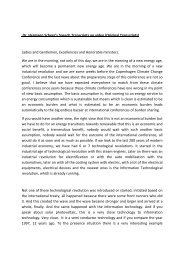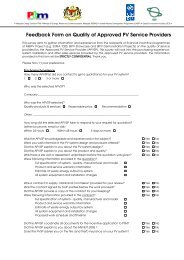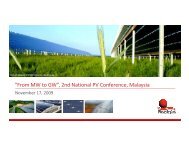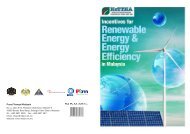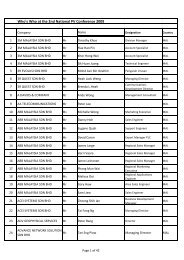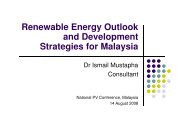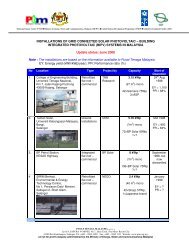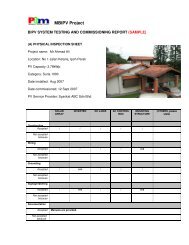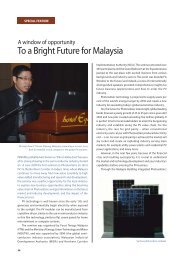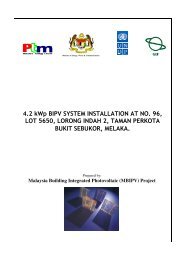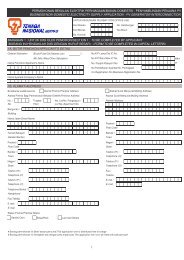MBIPV Project Brief
MBIPV Project Brief
MBIPV Project Brief
Create successful ePaper yourself
Turn your PDF publications into a flip-book with our unique Google optimized e-Paper software.
10. The total utility grid connected generation capacity in Peninsula at the end of 2001 was about12,600 MW of which 4,450 MW or 35% contributed by six IPPs and the remaining owned byTNB. In Sabah at the end of 2001, the grid generation capacity is 790 MW where 38% of thepower generation is contributed by five IPPs and the SESB. While in Sarawak, out of the totalgrid generation capacity of 880 MW, 320 MW owned by two IPPs and the rest owned bySESCO. In Peninsula Malaysia, out of the 12,600 MW installed capacity to the grid, 65% is gasturbine/combined cycle block, 13.5% hydro, 11.4% coal fired plant, 10.3% gas/oil plant (duelfuel) and less than 0.1 diesel engine. In 2001, about 80% of the electricity generated in PeninsulaMalaysia was by gas.11. Electricity peak demand is forecasted to increase from 10 GW in 2000 to 15 GW in 2005 and 22GW in 2010 for the peninsula. A total of 10,000 MW of new generation capacity will be plantedup and commissioned between 2003 until the year 2010, 5,700 MW will be coal fired powerplants and 4,300 MW natural gas fired power plants. By the year 2010, the fuel mix in PeninsularMalaysia will be 50% oil and gas, 40% on coal and the rest is on hydro and other renewablesources of energy.Table 1: Electricity Generation MixActual: 1993-1999; and <strong>Project</strong>ed: 2006-2010Energy Form\Year 1993 1995 1999 2006 2010Gas 64% 70 % 70 % 45% 45%Oil 10% 9% 16% 5 % 5 %Coal 14% 11% 7% 40% 39 %Hydro 12% 10% 7% 7 % 6%Renewable Energy - - 1 % 3 % 5%Source: Malaysia Energy CentreRENEWABLE ENERGY INITIATIVES IN MALAYSIA12. The Third Outline Perspective Plan (OPP3) and the Eighth Malaysia Plan (8th MP) are the twomain policy references for the promotion and development of renewable energy (RE) inMalaysia. The Third Outline Perspective Plan (OPP3) is Malaysia’s ten-year development planfor the period of 2001 to 2010. Under the OPP3, the government shall continue to undertakeefforts to manage both non-renewable and renewable energy (RE) resources to cater for thedemand of the rapidly growing economy. The main thrusts of OPP3 are as follows:• To ensure an adequate, secure, quality and cost-effective supply of energy;• To promote efficient energy utilization and minimize negative impacts on the environment;• To supplement the conventional supply of energy, new sources of energy such as renewableenergy (RE) would be encouraged.13. In the year 2000, the Government introduced the Fifth-Fuel Policy. The policy identified RE asMalaysia’s fifth fuel resource, which includes RE forms such as biomass, solar and wind. Withthis objective in mind, greater effort is being undertaken to encourage the utilization of renewableresources, such as biomass, biogas, solar and mini-hydro, for energy generation. Under theEighth Malaysia Plan (2001-2005), the Malaysian Government would intensify efforts toencourage the utilization of RE resources for the energy generation to supplement the supply6



